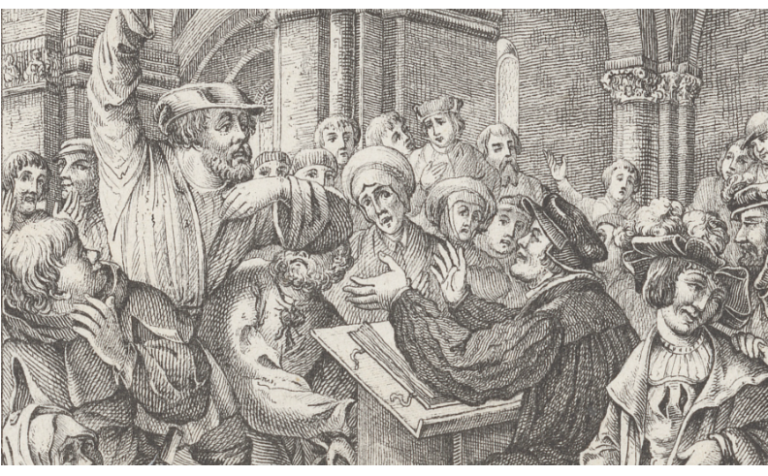An Unusual Detail That Points to Christ’s Cosmic Rule
Good stories frequently contain odd details. What might initially seem strange or random to the reader can later prove to be fascinating and full of meaning. For instance, have you ever noticed that Doc Brown’s bandana in Back to the Future Part III is made from the same fabric as his shirt in Back to the Future Part II? A seemingly ordinary piece of clothing takes on new significance when considered within the context of the overall story.
There’s a similarly peculiar yet significant detail in Mark 16. The ending of Mark’s Gospel has been a point of contention for some commentators because it doesn’t explicitly describe a resurrection appearance (vv. 1–8). In contrast, Matthew, Luke, and John all tell of Jesus appearing to the disciples and to two women. However, an odd detail in Mark’s ending might explain why Jesus doesn’t have a post – resurrection appearance in this Gospel. Could an angel’s mysterious posture hold an important clue?

Vivid Description
Mark 16 begins with three women—Mary Magdalene, Mary the mother of James and John, and Salome—heading towards Jesus’s tomb at dawn on a Sunday (vv. 1–2). As they walked, the women wondered who could move the large stone that sealed the tomb. But when they arrived, they were surprised to find that the stone had already been rolled away (vv. 3–4).
The women entered the tomb and saw “a young man sitting on the right side [kathēmenon en tois dexiois], dressed in a white robe” (v. 5). Mark provides three vivid details here: the presence of an individual (a “young man”), the man’s clothing (“white robe”), and his posture and location (“sitting on the right side”).
Repeated Wording
These specific details surely emphasize the three women’s eyewitness account. However, there might be another important reason Mark mentions them. He may have included the strange detail of the angel “sitting on the right side” (kathēmenon en tois dexiois) because of its symbolic meaning.
A literal translation of the phrase is “seated on the right.” Often, the adjective “right” (dexios) appears on its own, and the implied noun is determined by the context (e.g., Matt. 6:3; Mark 10:40; Luke 1:11). In Mark 16:5, the “right” probably refers to the “right side” of the bench inside the tomb. But “sitting at the right” only appears two other times in Mark’s Gospel:
“David himself, inspired by the Holy Spirit, declared, ‘The Lord said to my Lord, “Sit at my right hand [kathou ek dexiōn ], until I put your enemies under your feet.”’” (12:36)
And Jesus said, “I am, and you will see the Son of Man seated at the right hand [ek dexiōn kathēmenon] of Power, and coming with the clouds of heaven.” (14:62)
These two passages quote the crucial prophecy from the Greek translation of Psalm 110:1: “Sit at my right hand [Kathou ek dexiōn] until I make your enemies your footstool.” Psalm 110 is a prophecy about the enthronement of a pre – existent, divine, and messianic figure. At the end of history, this figure will rule over all of God’s enemies (vv. 2, 5–6).
An Intended Allusion? Absolutely!
Is the angel’s mysterious posture an allusion to Psalm 110? Does it symbolize Jesus’s initial fulfillment of the psalmist’s grand prophecy? If so, the angel’s “sitting on the right” of the bench represents Jesus’s “sitting at the right” hand of the Father.
Is there more evidence in the text to support this conclusion? As mentioned earlier, Mark quotes Psalm 110 twice earlier in his Gospel (12:36; 14:62) and then subtly alludes to it at the end. Also, consider that the angel wears a “white robe,” the same kind of clothing Jesus wore during the transfiguration (9:3). “Sitting on the right” is not an insignificant detail. The angel’s appearance is central to Mark’s message.
Mark wrote his Gospel to show that Jesus is Israel’s king, or “Messiah,” and the divine “Son of God” (1:1). Even though the ascension was still weeks away, Christ’s faithful ministry, death, and resurrection had already qualified him to sit on the throne at the Father’s “right hand.” At the resurrection, Jesus began to rule over all of God’s physical and spiritual enemies, including death itself.
The angel’s “sitting on the right” of the bench represents Jesus’s “sitting at the right” hand of the Father.
Does this line of thinking seem unlikely? Consider how prominent Psalm 110:1 is in the New Testament. When we count all the allusions to and quotations from the Old Testament in the New Testament, Psalm 110:1 is by far the most referenced passage. We can be certain that Psalm 110 was a guiding and influential prophecy. We also have examples in the Old Testament of an “angel of the Lord” acting as a special representative of God on earth (e.g., Ex. 3:2; 23:20; Num. 22:22–27; Judg. 6:11–12; 13:20–21). The angel does what God does.
Pay Attention to Unusual Details
Now that we’ve looked closely at this unique element in Mark’s narrative, what can we learn? The Gospel writers include only the most relevant information in their stories. They don’t share every historical detail they know.
For example, in Mark 16:5, only one angel is in the tomb, while Luke 24:4 says there were two. Is this a contradiction? No, Mark doesn’t say there was only one angel. He simply focuses on one angel and how that angel functions in the scene. The Gospel writers only included details that have interpretive value.
Knowing that the Gospel writers don’t include anything unnecessary should change the way we read. When you open the Gospels, analyze each scene and ask these questions: Where does the story happen? Who is present? Who is speaking? What are they saying? Are there any allusions or quotations from the Old Testament? How does the event relate to what came before and after it? Why is this passage in the Gospel? And, most importantly, how does the scene help us understand Christ and his work?
When you encounter something strange in a passage, take the time to study it. Consult comprehensive commentaries and look up the passage in the Scripture index of Bible dictionaries and encyclopedias. Above all, doing a word study is often the best way to understand these types of details. What seems odd to you might end up being a source of encouragement.





